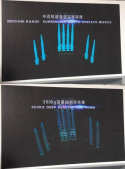The reason why warning time is important, is not primarily due to the ability of Guam to get its aircraft off the ground.
Rather, the reason why warning time is important, is that it allows the missiles and/or aircraft that are launched from land to be tracked for 3000-4000km from their launch sites to Guam, and enable rings of US air and missile defenses between the first island chain, up to and including Guam, to be able to have longer opportunities to discriminate and track targets enabling a higher chance of successful interception, as well as more opportunities to intercept them as well.
Being able to launch weapons closer to your target not only reduces the time that the opfor is able to track the missiles that you've launched (thus reducing chances of a successful interception), but also reduces the opportunities to intercept them as well.
Think about Guam's defenses as a multilayered onion that has to be peeled through to get to the core.
The outermost layer, in the 1st island chain, are US assets in the first island chain. Land based BMD radar and BMD batteries, land based fighters with AEW&C, and even naval ships with BMD capability.
The middle layer is between the 1st and 2nd island chain, composed of carriers, naval ships with BMD, and perhaps small islands with forward deployed smaller BMD radars and BMD batteries.
The final layer is in the 2nd island chain, including Guam and smaller islands that have their own land based comprehensive BMD and land based airbases with fighters and AEW&C, as well as escorting naval ships with BMD, perhaps carriers as well.
All of those layers will seek to track PLA land based missile and aircraft attacks launched towards Guam, as well as seek to shoot them down and thin them down as much as possible before they reach Guam. In other words, PLA attacks from land will have to go through three layers of defense, because at the commencement of hostilities, those land based weapons are naturally not forward deployed close to Guam.
Now, for SSNs with VLS, if they are routinely deployed close to Guam in the 2nd island chain, they are able to bypass basically the outermost layer and middle layer of defenses, straight to the final layer of defenses -- or perhaps even get within the final layer of defenses! That is in addition to the fact that they can attack from other directions where the outermost and middle layers of defenses are either weak or absolutely nonexistent by virtue of the geography of the middle pacific.
That is why the importance of having routine forward deployment close to potential targets is important.
As I wrote before, yes the PLA can try to conduct offensive strikes against the outermost and middle layers of defense that the US has, to weaken them to enable a strike with greater chances of success against Guam. And I expect the PLA to do so.
But that will require time and materiel, and even then I believe the likelihood of success will remain greatly enhanced when a large fraction of the first strike is delivered by a number of SSN-Gs that are already prepositioned and operational close to the target.

